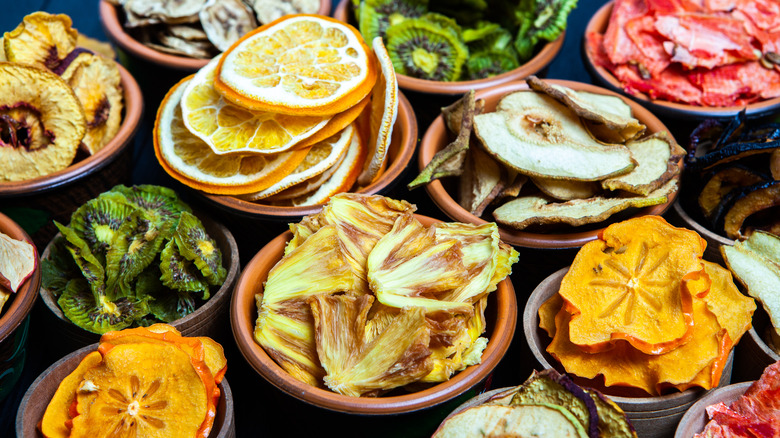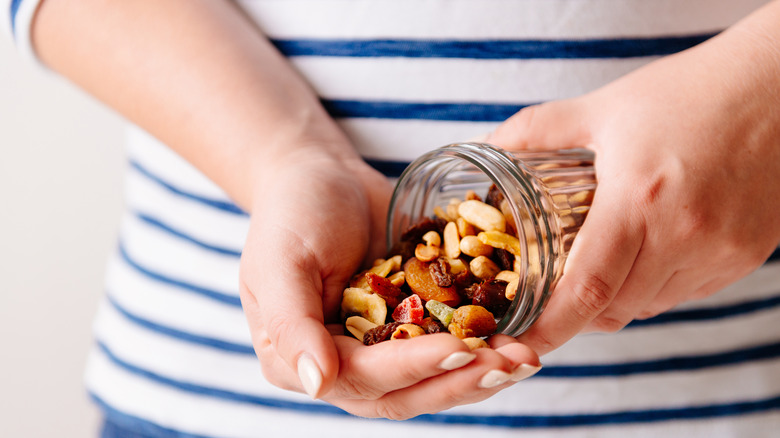Is Dried Fruit Good For You?
Do you find yourself snacking on raisins, banana chips, or goji berries while watching your favorite TV show? While it's true that dried fruits pack a hefty nutritional punch, they're also high in calories and sugar. For example, a 1-ounce serving of raisins has 85 calories and 22.5 grams of carbs, including 18.5 grams of sugar, reports My Food Data. The same amount of grapes has about 19 calories and 4 grams of carbohydrates, including 4.6 grams of sugar. Raisins are more calorie-dense than grapes because they've had most of the water removed through drying methods.
Dried fruits are chock-full of vitamins, fiber, and antioxidants, but you still need to watch your portions. "Diets rich in fiber, found in dried fruit, are associated with a reduced risk of digestive diseases, heart disease, and obesity," said registered dietitian Whitney English Tabaie in an interview with Well+Good.
The antioxidants in prunes, apple chips, and other dried fruits protect against oxidative stress and support overall health. For example, a 2013 review published in the Journal of Food Science suggests that raisins may improve blood lipids and glycemic control, leading to a lower risk of heart disease and diabetes. Moreover, they increase satiety and may help reduce food intake, due to their high fiber content. But despite these benefits, you should think twice before snacking on dried fruits. After all, they are called "nature's candy" for a reason.
Dried fruits are packed with sugar
The downside is that dried fruit is high in sugar and carbs, which offsets its reputation as a healthy snack. Dried cranberries, for instance, pack a whopping 70 grams of sugar per 3.5 ounces, according to My Food Data. A Snickers bar, by comparison, has less than 30 grams of sugar. On the positive side, dried cranberries are loaded with calcium, potassium, and antioxidants.
Both fresh and dried fruits contain sugar in the form of fructose. When consumed in excess, fructose can lead to obesity, non-alcoholic fatty liver disease, digestive disorders, and diabetes, according to a review published in Alternative Medicine Review. On top of that, food manufacturers may add sugar to dried fruits for extra flavor. To stay on the safe side, check the label for terms like "candied" or "crystallized."
Another drawback of dried fruit is it's easy to go overboard when eating them because of their small size. "If you remove the water from fresh fruits, it will reduce the serving size to about 75%," explained senior clinical dietitian at Texas Children's Hospital, Kristi King, in an interview with Time. It takes minutes to finish a bag of banana chips, so the calories can add up quickly. But this doesn't mean you should give up dried fruits completely — it all comes down to portion control.
The healthiest way to enjoy dried fruit
As you can see, dried fruit isn't necessarily unhealthy. On the contrary, it can boost your nutrient intake and keep you energized throughout the day. Moreover, certain fruits have specific health benefits. Prunes, for instance, may relieve constipation and keep you regular due to their high content of soluble and insoluble fiber. Raisins may reduce blood sugar levels and improve heart health, according to research published in Postgraduate Medicine. Dried figs are higher in calcium than any other fruit, reports MedicineNet. Therefore, they keep your bones strong and can make it easier to meet your calcium requirements, especially if you're a vegan.
All in all, there's no reason to avoid dried fruits. Just make sure you choose unsweetened varieties and keep an eye on your portions. "Pairing dried fruit with a handful of nuts is a great way to balance your snack," says dietitian Whitney English Tabaie (via Well+Good).
You may also add dried cranberries or other dried fruits to chicken salad, oatmeal, and other high-protein meals, suggests Tabaie, to prevent blood-sugar spikes and discourage overeating by making you feel full. Ideally, snack on dried fruits after exercise so that your body can use the extra carbs to replenish its glycogen stores and recover from training.


